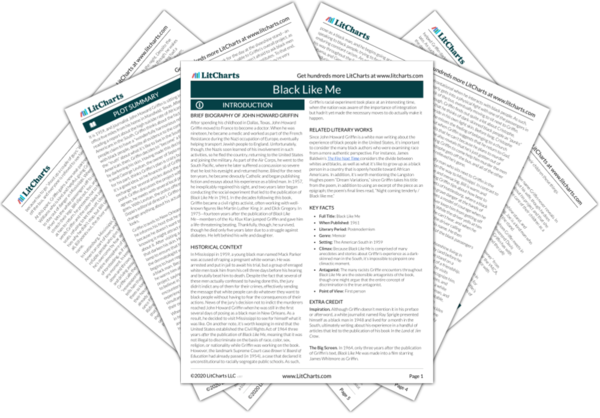Brief Biography of John Howard Griffin
After spending his childhood in Dallas, Texas, John Howard Griffin moved to France to become a doctor. When he was nineteen, he became a medic and worked as part of the French Resistance during the Nazi occupation of Europe, eventually helping transport Jewish people to England. Unfortunately, though, the Nazis soon learned of his involvement in such activities, so he fled the country, returning to the United States and joining the military. As part of the Air Corps, he went to the South Pacific, where he later suffered a concussion so severe that he lost his eyesight and returned home. Blind for the next ten years, he became devoutly Catholic and began publishing fiction and essays about his experience as a blind man. In 1957, he inexplicably regained his sight, and two years later began conducting the social experiment that led to the publication of Black Like Me in 1961. In the decades following this book, Griffin became a civil rights activist, often working with well-known figures like Martin Luther King Jr. and Dick Gregory. In 1975—fourteen years after the publication of Black Like Me—members of the Ku Klux Klan jumped Griffin and gave him a life-threatening beating. Thankfully, though, he survived, though he died only five years later due to a struggle against diabetes. He left behind his wife and daughter.
Historical Context of Black Like Me
In Mississippi in 1959, a young black man named Mack Parker was accused of raping a pregnant white woman. He was arrested and put in jail to await his trial, but a group of enraged white men took him from his cell three days before his hearing and brutally beat him to death. Despite the fact that several of these men actually confessed to having done this, the jury didn’t indict any of them for their crimes, effectively sending the message that white people can do whatever they want to black people without having to fear the consequences of their actions. News of the jury’s decision not to indict the murderers reached John Howard Griffin when he was still in the first several days of posing as a black man in New Orleans. As a result, he decided to visit Mississippi to see for himself what it was like. On another note, it’s worth keeping in mind that the United States established the Civil Rights Act of 1964 three years after the publication of Black Like Me, meaning that it was not illegal to discriminate on the basis of race, color, sex, religion, or nationality while Griffin was working on the book. However, the landmark Supreme Court case Brown V. Board of Education had already passed (in 1954), a case that declared it unconstitutional to racially segregate public schools. As such, Griffin’s racial experiment took place at an interesting time, when the nation was aware of the importance of integration but hadn’t yet made the necessary moves to do actually make it happen.
Other Books Related to Black Like Me
Since John Howard Griffin is a white man writing about the experience of black people in the United States, it’s important to consider the many black authors who were examining race from a more authentic perspective. For instance, James Baldwin’s
The Fire Next Time considers the divide between whites and blacks, as well as what it’s like to grow up as a black person in a country that is openly hostile toward African Americans. In addition, it’s worth mentioning the Langston Hughes poem “Dream Variations,” since Griffin takes his title from the poem, in addition to using an excerpt of the piece as an epigraph; the poem’s final lines read, “Night coming tenderly / Black like me.”
Key Facts about Black Like Me
-
Full Title: Black Like Me
-
When Published: 1961
-
Literary Period: Postmodernism
-
Genre: Memoir
-
Setting: The American South in 1959
-
Climax: Because Black Like Me is comprised of many anecdotes and stories about Griffin’s experience as a dark-skinned man in the South, it’s impossible to pinpoint one climactic moment.
-
Antagonist: The many racists Griffin encounters throughout Black Like Me are the ostensible antagonists of the book, though one might argue that the entire concept of discrimination is the true antagonist.
-
Point of View: First person
Extra Credit for Black Like Me
